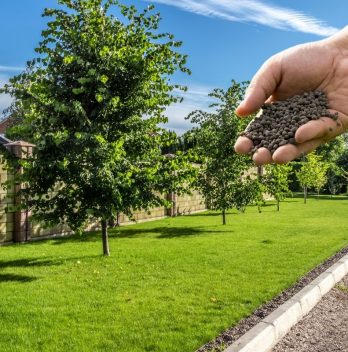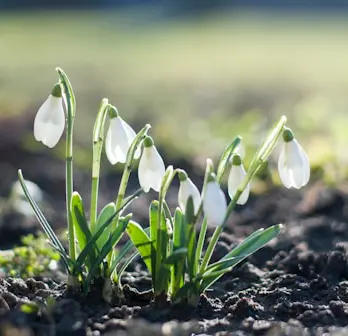Gypsum application is a great idea if you want to improve your lawn’s health. For this reason, choosing the most appropriate gypsum for your lawn is fundamental.
When you apply gypsum to your lawn, it will rectify most of your lawn problems. It will bring your lawn back to life and improve your turf’s growth.
We will discuss more of why gypsum is needed for your lawn, some of its benefits, and recommend some gypsum you can apply to your lawn.
Why You Need Gypsum for Your Lawns
If you are particular about giving your lawn that beautiful green look, you will need gypsum.
You need gypsum for your lawn, especially during the winter months. When the cold, snowy winter approaches and your area is salty (especially coastal and arid regions), salt tends to gather up near the melted ice, giving your turf unpleasant patches, which can damage your lawn.
However, applying gypsum to your lawn will help it survive winter and emerge from it flourishing.

Gypsum will control this salt by making it leach away into the subsoil. The salt will be leached below the roots of your lawn. Therefore, the root of your lawn remains harmless.
With gypsum application, much water will be needed to help the leaching process.
Gypsum not only removes excess salt, but it also replaces salt with calcium in the soil. As such, there will be a great deal of improvement in the
What is Gypsum
Gypsum is a naturally occurring mineral of calcium sulfate dihydrate (CaSO₄·2H₂O). Due to its beneficial properties, it’s widely used in construction, agriculture, and various industries.
Common Uses of Gypsum:
- Construction: Gypsum is a key component of drywall or plasterboard, often called sheetrock. It’s also used in plaster and cement to control setting times.
- Soil Amendment: In agriculture, gypsum improves
soil structure and drainage. It helps to break up compactedsoil , especially in clay-heavy soils and provides essential nutrients like calcium and sulfur. - Gardening: Gardeners often use gypsum to improve
soil quality, reduce compaction, and prevent salt buildup, particularly in regions with hard or saline soils. - Industrial Applications: It’s used as an additive in the production of fertilizers, ceramics, and even some food processing.
Gypsum is valued for its versatility, making it applicable across various fields.
Benefits of Applying Gypsum to Your Lawns
There are other benefits you get to enjoy using gypsum for your lawns. Just take a look at some benefits of feeding your lawn with gypsum:
- Reduces Coil Compaction: if the
soil in your area is compact, especially claysoil , gypsum will greatly help thesoil . Gypsum will help diminish the compaction ofsoil , which in turn opens up the pours in yoursoil . This helps increase the condition ofsoil aeration in your lawn. Now, your lawn will enjoy that full, thick, beautiful turf look! - Neutralizer for Pet Urine: most homeowners with pets suffer from pets urinating on their lawns. Pet urine is not healthy for your lawn. It can cause yellow patches on your lawn, and they may not recover, making it unpleasant to the eyes. The good news is gypsum can serve as a neutralizer for pet urine, solving the problem of yellow spotting on your lawn. It is a harmless neutralizer and safe for humans, pets, turf,
soil , and plants.
Recommended Gypsum For Your Lawns
Below are some recommended gypsum for your lawns:
Gypsum Powder – Purest and Soluble Houseplant Food Fertilizer
We suggest Gypsum Powder from Supply Solutions gypsum
Another advantage of the Epsoma gypsum
Pros
- Neutralizer for pet urine.
- Improves heavy clay soils rapidly.
Cons
- If enough water is not added to leach away salt, the product might not work well.
For Indoor Plants, Outdoor, Lawn, Vegetables – Indoor Plant Nutrients, Improve Plant Growth (50 P…
The Andersons NutraSoft OP Pelletized Gypsum
The Andersons NutrSoft OP Pelletized gypsum will benefit your lawn and work very fast! It will help break up those thick soils, making the turf’s roots easier to work through and receiving more air circulation.
The Pennington gypsum will work wonders on your lawn, making them grow green and healthy.
Pros
- Quickly disperses and dissolves into the
soil after irrigation - Faster and more effective than traditional gypsum products
Cons
- None that we could find yet.
6,600 sq ft 40 lb Bag
Earth Science Fast Acting Gypsum
Earth Science Gypsum is a type of pelleted gypsum that will boost the growth of your lawn, make your turf green and attractive, and help repair salt-damaged soils from pets or roads.
It will also help loosen and improve tightly packed heavy and clay
Pros
- Neutralizes salt de-icing from winter.
- Loosens clay and compact soils to promote growth.
- Safe for Pets and Children
Cons
- Lots of water is needed for the leaching process.
Soil Conditioner Adds Calcium, Repairs Salt Damage & Root Growth with Nutri-Bond Runoff R…
How do you apply gypsum to your lawn?
Applying gypsum to a lawn is a simple way to improve
Step 1: Test Your Soil
Before applying gypsum, it’s important to test your
Step 2: Choose the Right Type of Gypsum
Gypsum comes in various forms, including:
- Powdered: Easy to spread but can be dusty.
- Granular or Pelleted: Easier to handle and spread, especially for large lawns.
Step 3: Calculate the Application Rate
For most lawns, apply gypsum at 20 to 50 pounds per 1,000 square feet. Check the packaging for specific recommendations for your lawn’s needs, as the rate may vary based on
Step 4: Spread the Gypsum
- Manual Spreading: Use a handheld or broadcast spreader to distribute the gypsum evenly.
- Mechanical Spreader: A mechanical spreader will make the task easier and ensure even coverage for larger areas.
Step 5: Water the Lawn
After spreading gypsum, water the lawn thoroughly to help the gypsum penetrate the
Step 6: Reapply if Needed
You may need to reapply gypsum once or twice a year for heavily compacted soils. Regular applications can help prevent
By following these steps, you’ll enhance

Eunice is an enthusiastic gardener with a passion for growing beautiful flowers. She loves nothing more than spending time in her garden, tending to her plants and enjoying the outdoors. Eunice has been gardening for over 15 years and has developed a unique style of landscaping that is both practical and aesthetically pleasing. She is especially fond of growing roses and enjoys experimenting with different varieties and colors. Eunice takes great pride in her garden and often shares the fruits of her labor with friends and family. In her spare time, she enjoys reading gardening magazines and attending local horticulture events. Eunice is passionate about her hobby and is always eager to share her knowledge and experience with others.








